Reader. Dreamer. Writer.
A hijra, a woman and a baby tangled in a web of Indian politics and social injustice. Arundhati Roy’s second novel, The Ministry of Utmost Happinesswas published with much hype in the literary world.
In Brief
The story revolves around Anjum (born Aftab), a hijra (transgender) living in Delhi and Tilo, whose lover Musa is trapped in the unrest in Kashmir. A baby, adopted by one and absconded by the other, forms a bond between the two women. In between their individual stories are the stories of Maoists, Gujrat, Kashmir, mushrooming political leaders and the unconsoled (for whom the book is dedicated).
Review
“Why should a novel be about one thing?” – asks Chimamanda in her latest novel, Americanah which charges at a truck load of issues strongly woven into the plot. Arundhati Roy seems to ask the same question with her second novel, twenty years after her first, though with a bit of waver in its voice. The premise of the novel is present day India which is an applaud-able feat. While there are many novels written on the Independence movement (Rushdie’s Midnight’s Children), Emergency period (Rohinton Mistry’s A Fine Balance), Naxalite movement (Neel Mukherjee’s The Lives of Others), and many more, we seem to be in want of yet another one that so blatantly points out the happenings in the ‘now’ of India.
Reading the book as an Indian who is aware of the current affairs in the country is certainly a bonus. Arundhati has spared none and included the pioneers who have made (or marred?) history including the silent prime minister (Manmohan Singh), Gujrat ka Lalla (Narendra Modi), Trapped Rabbit’s government (Congress party), old man with gummy Farex- baby smile (Anna Hazare) and the commoner Mr. Aggarwal (Kejriwal) in her book. The Anna Hazare movement that was praised as the ‘Second freedom struggle’ rose and fell at the same exponential rate and one of the characters in the book calls it the ‘motherfucker of all scams’. However, the book can be read and enjoyed at a different level without a deep understanding of Indian politics even if you do not know the real-life-persons who are mocked at.
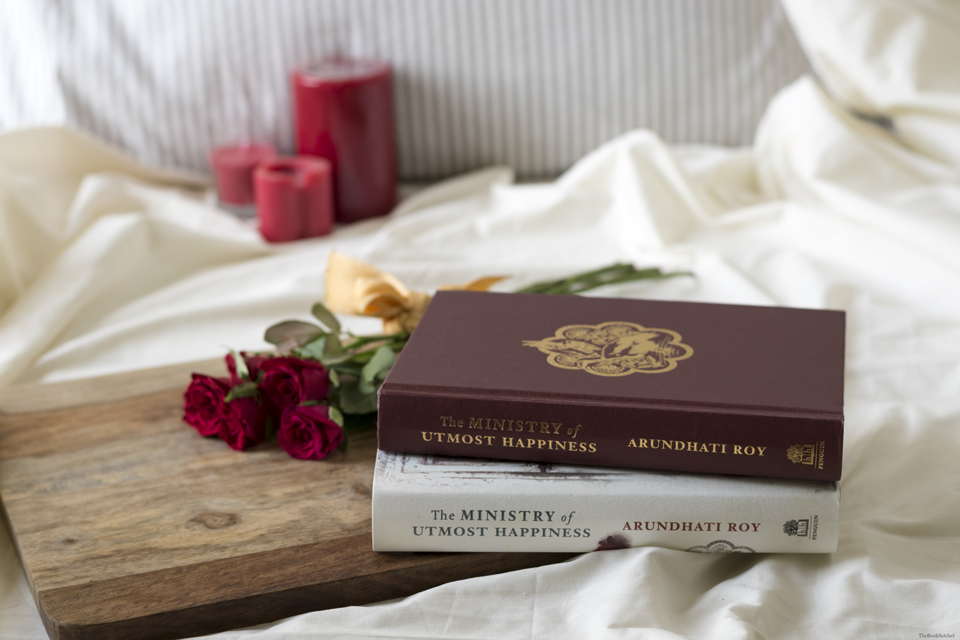
Arundhati wants to put the whole of India, the diversity and the plethora of problems that come with it into 400+pages. So we have it all here – all of India, including the hijra community, treatment of Dalits (lower castes) in the new India, the Bhopal gas tragedy, the Anna Hazare movement, the dying of Urdu language, the rise of Hindu fanatics (‘saffron parakeets’ as Roy calls them), hatred towards the Muslim community, the prime ministers of the last few decades and ‘gau rakshaks’ (protectors of cow who say it is a holy animal). Some issues are dealt with in a more subtle manner such as the environmental hazards of plastics on animals, the spam text messages (I was glad she put that in. Seriously drives everyone crazy and no one seems to know how to completely stop receiving them), the migration of nurses from Kerala to Gulf, the fake American accent that clutches Indian throats as soon as they land in America, the usage of substandard cement in buildings, organ harvesting, hypocrisy of media that treats the fallen as mere ‘news items’, unavoidable bribery in offices and the prejudice of North Indians against the dark skinned South Indians.
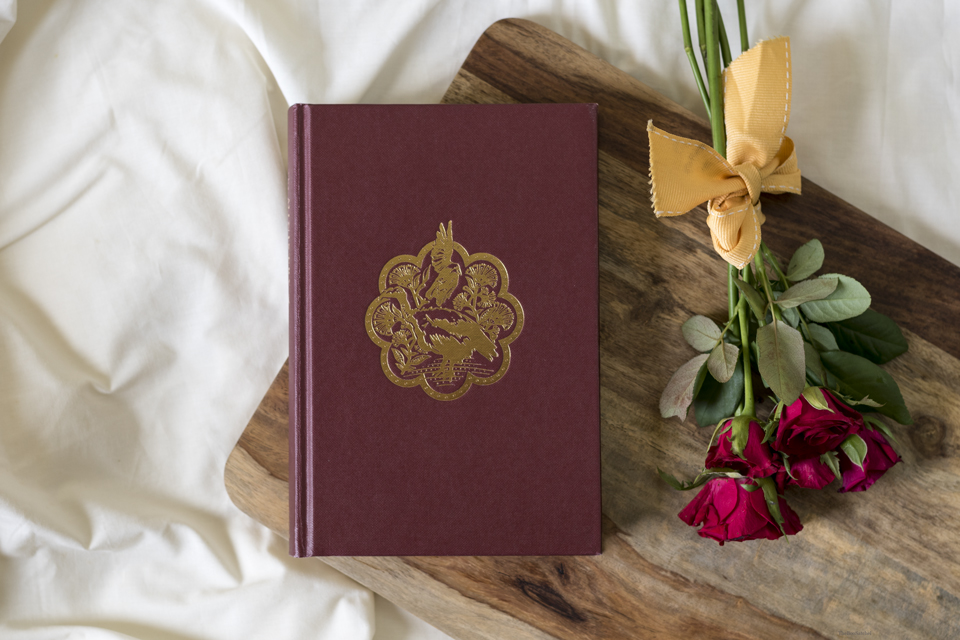
Since the book tackles a lot of present-day issues, the reader is met with frequent authorial intrusions given in brackets. While this method enhanced the reading experience in Arundhati’s first novel, it does not allow the reader to melt into the world of Anjum and Tilo because of the constant reminders that there is an author lurking behind them who wants to emphasize (the tell-not-show technique perhaps?) some facts. Even though I was disturbed by the generous use of brackets in the book, it is ironical that I have included a lot many brackets in this review because there is no other way I can describe this book in a more effective way.
The Ministry of Utmost Happiness is no easy read and I had to take several breaks to digest the quantity of information put forth in each page. Not that I have any regrets about reading the novel because this is like a quick bullet list of the present political developments in India. The book almost feels like a student’s revision notes and the author fails to go deep into any of the issues. The reader has to be satisfied with the superficial layers or resort to research on their own to expand the various points fleetingly mentioned in the book.
A major shortcoming of the novel is the lack of focus. Arundhati Roy tries to fit in more issues than the plot can handle. The plot often feels like a lost child and by the time we wade back to it through the dark waters, one feels tired and not as enthusiastic to finish it. Since so many real-life characters were fictionalized in the book, often I found myself stumbling over the actual fictional characters and trying to google them out in case I was less informed of the political scenario – This was a frustrating task indeed. The ending was disappointing and seemed forced (There is a baby who is central to the plot; but frankly I did not care much for it).
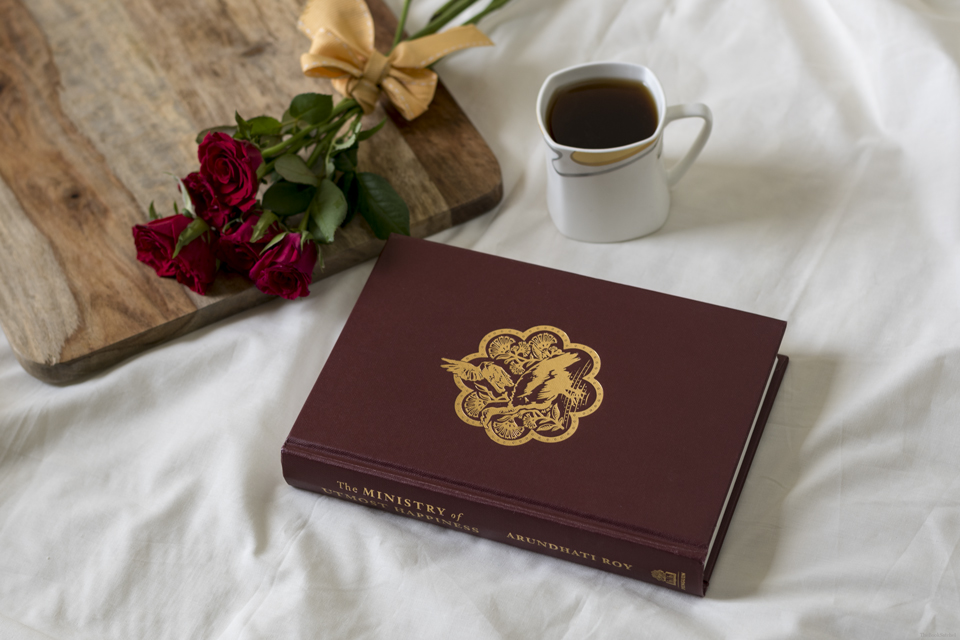
The characters are weak (and the minor characters too many) in The Ministry of Utmost Happiness, perhaps because they are secondary to the overall political nature of the novel. In the beginning I was really invested in Anjum and her struggles in an Indian society as a transgender. Arundhati is successful in bringing to light the small problems within the community (such as the time when Anjum, the favourite hijra of the press and media is slowly replaced by the new hijra who knows fancy English words such as ‘cis’, ‘MtoF’ etc). However midway, Roy leaves Anjum and a baby and abruptly flies straight into the Kashmir problem that continues for several pages. By the time we make our way back to Anjum, I had no interest in knowing what happens. Tilo, in my opinion, was an extremely weak character and the plot could have been crisper had the character been omitted from the novel. She does not do significant contributions to the plot except in being the fictional Arundhati (much like Rahel in The God of Small Things, who on the other hand was a strong character) and reminiscing about her mother Maryam Ipe (based on real-life Mary Roy, Arundhati’s mother, with traces of the fictional Ammu of The God of Small Things). As a fan of Arundhati’s writing, I was delighted to make the connections between the two novels and Arundhati’s own life, but I doubt if a new reader would be as patient as the book requires him to be.
The main prerequisite to enjoy this novel is patience. To prove this point, here is a small example of how Arundhati writes about the ‘dictionary in Kashmir’. You have two pages with frequently used words from A to Z. This might look as an experimental inclusion in the book but it packs the whole gist of the Kashmir issue in alphabetical order. The writing is beautiful and uniquely descriptive; there are quotes strewn about the novel such as “Where do old birds go to die?”, “Enemies can’t break your spirit, only friends can” which force the reader to enter into a moment of quiet reflection.
Magical Realism?
There have been whispers and publicity pieces on the internet that say the book falls into the genre of magical realism. I am afraid that is not true (except for stray references like the one incident of breaking open lungs of stone to free the soul Pg. 258 or Tilo visiting Musa through “the crack in the door that the battered angels in the graveyard help open (illegally) for her” ) and the book is overtly realistic in its tone. There is a reference to Gabriel Garcia’s fictional town of One Hundred years of Solitude which Roy uses to describe the ‘Macondo madness’ in India. Perhaps an alienation with the Indian way of living might have made some descriptions seem a bit magical, but these are real incidents happening around and these are not sufficient to brand the book as a work of magical realism.
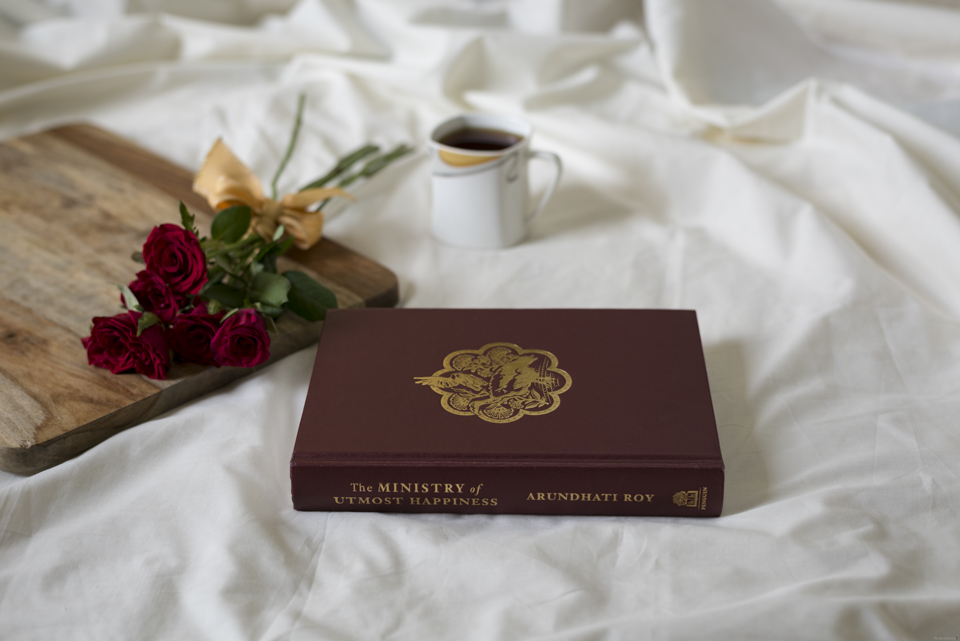
Comparison with The God of Small Things
One cannot help foraging for broken mirrors of Arundhati’s brilliant debut novel in the new one even though she has told that her readers can expect anything other than another The God of Small Things. And she is absolutely right. Both the novels are distinctly different except for some non-lustrous resemblances. For example, Tilo would be the fictional child of Ammu and Velutha of The God of Small Things, had their story ended differently. Arundhati uses her same techniques of repetition, capitalization and authorial interjection via brackets for emphasis as well as frequent shifts between the past and present during the narration. While her debut has the charm of lyrical prose swathed in beauty even when tragedy strikes her characters, the setting of The Ministry of Utmost Happiness is more dingy, grim and as real as the streets of Delhi. The God of Small Things is more plot driven while the new book has many important subplots that seem to get a bit lost inside the ministry.
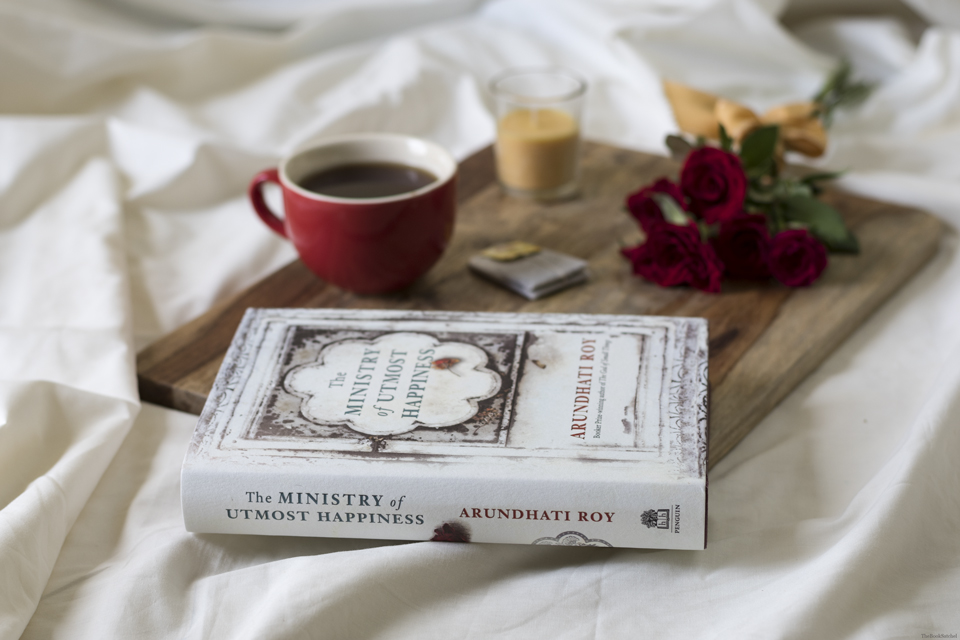
To Read or Not to Read?
This is the most difficult question. The answer depends on what you expect from the novel. If you are a fan of The God of Small Things and the beautiful prose and unique metaphors used, Arundhati’s new novel would let you down. If you are non-judgmental enough to accept a novel that is so unlike its predecessor, you will find this to be a thought provoking one. The novel works as a ‘Roy-novel’ but if this was penned down by a less acclaimed novelist, perhaps it would not have been received by readers and the literary world in the same way. Read it with intermittent short breaks, allow it to grow in your mind and you will feel happy that you picked it up.
Arundhati is a brave writer who does not allow herself to succumb to a stereotyped version of herself. When she wrote a masterpiece as The God of Small Things; the world yearned for a second novel. She surprised us all by turning into an activist who ‘walked the talk and wrote the walk’. Then after twenty years, she surprises us again with a very different book, that is steeped in realities, delicious but also nothing a faithful reader would have dreamt of. If I have to recommend one of the two novels of Roy, it would be The God of Small Things that proves her finesse as a writer. But maybe you are as brave a reader as the author who wrote this novel (a little less pretty; a bit more controversial; a bit too long in want of some clipping; highly ambitious; genuinely flawed) with many loose ends but which speaks a lot of truth about today’s India. If you would like to be shocked, to be sucked into a cobweb of the dirty world of politics and social injustice, gift yourself this book today; I whole heartedly recommend it.
Title : The Ministry of Utmost Happiness
Author : Arundhati Roy
Publisher : Hamish Hamilton
Published : 2017
Language : English
Pages : 464
Rating : 4/5










Interestingly, Americanah and The God of Small Things are 2 books which are part of my birthday book haul. I plan to get to them this month, I will revisit this review after I read those 2 books
You have had an excellent book haul in that case. Americanah is a faster and more engaging read; so I would recommend you to start with that one. The Ministry of Utmost Happiness is best had in small bites. It can be a little overpowering because of dealing with a lot of issues.
I hope you will enjoy both the books.
Thanks Resh! I love your recommendations…please let me know if your planning any readalong soon
Sure I will. As of now, nothing on the cards.
Awesome! Thank you
I don’t think this is for me but I love your comparison of what sounds like an unwieldy plot to a lost child.
Thank you. I thought that was the best way to convey how the plot reads like. 🙂
As always, I am eternally grateful for your insightful book reviews. This book has been on my radar since it came out, and I can’t wait to delve into it myself. I loved “The God of Small Things,” and I remember too that Karan Mahajan alluded to Roy in his book “The Association of Small Bombs.” It also reminds me of another book with brackets, some kind of authorial voice within the pages in a fiction book — Alain de Botton’s “The Course of Love” which actually worked for me. I wonder if it has the same intent — looking forward to it!
I did not know Mahajan mentions Roy. I need to check that book. De Bottom’s book is on my TBR so I will keep the fact about brackets in mind.
Great review! I’ve read a few others that were also critical of the unfocused story line, so I think I will skip this one for now and read The God of Small Things instead.
The God of Small things is a wonderful novel and I hope you will enjoy the read. It is one of my favourites
This is a brilliant review of a complex sounding book! I don’t know that it’s a book for me, but I really enjoyed reading about it. I would like to know more about the current state of affairs in India and am intrigued by this, so who knows, maybe one day?
Who knows? Maybe you will pick it up. It is a complex one indeed
Like a “lost child”–well,put. Very thorough and helpful review.
Thank you Lisa. That seemed like the best way to describe it. 🙂
Great review! I haven’t read either book, but I love that you compared them, especially because I think a lot of people will be reading one because of the other. I’m not sure about “The Ministry of Utmost Happiness”, but I know I want to read “A God of Small Things”. Although, like Laila, I’d like to know more about current India. Both of the titles are great!
Yes, both the books are very different and can be enjoyed at different levels. The God of small things is one of my favourite novels and I recently re read it before this new book was released. I hope you will enjoy it when you pick it up
I have just finished! (I was saving your post). On the subject of The God of Small Things which I remember loving I haven’t read it for 20 years so my memory of it is sketchy.
However I thoroughly enjoyed it, it is complex, and there’s some difficult content but I loved the characters of Anjum and Tilo and Musa. I loved the baby thing and those scenes in the houseboat were some of my favourite. But the Jannat Guest house and all the characters there will really stay with me.
I am so glad to hear that you enjoyed the novel. It is a novel that grows on you (atleast for me). So I am sure you will be reminded of the book and the characters several times over the next week.
I think the Jannat House was a wonderful section of the novel and I realise I did not mention it in this (already-too-long) review. I loved how Anjum comes to the graveyard and literally begins her whole life anew; a place very different from her (Aftab’s) home and the hijda community-house. And she makes rooms for everyone. I think the Jannat guest house is like the whole of India- people with different religious and social beliefs come together and stay together. And Anjum is practically building a new world where all are welcome. I found Tilo to be a weak character though I loved mapping Tilo and Arundhati’s actual life. I loved Anjum in the book and she seems to be the one full of positivity. A remarkable thing about Anjum is I didn’t see her complaining in the book. Usually a book on a transgender would have sections sometimes inserted to evoke sympathy. But Arundhati treats her like any other human being. And I loved how Roy went into the trivial details of Anjum’s life, like when the hair on the face starts to grow etc. It made her even more relateable and made me sympathise with her hardships.
I really admire her, and I wasn’t one who end-to-end adored the first novel, so I suspect I will find this one interesting (not really having any set expectations in terms of style or narrative).
I’m very curious about the aspect of the plot involving a baby which interfered with your enjoyment of it (don’t tell me – I’m just saying! :)) and wonder if I’ll find it troublesome too. It’s not one that I am rushing towards, but it’s definitely on my reading radar.
Also, I’m with you on the way in which critics/reviewers/readers use the ‘magical realism’ label: sometimes it fits with my understanding of the technique and other times it doesn’t. Sometimes I think the disparity is because I’m not well-read enough and other times I don’t think that’s the case, rather someone’s need to “label” something disorienting/uncomfortable in the story. In any case, it gets me thinking!
I hope you will enjoy the book if you pick it up. I will look forward to your review especially if you felt the ‘baby’ part was a bit forced. I was really shocked to see some reviewers calling it as magical realism. Magical realism is another genre in itself. And just because Roy has mentioned a line that leans towards magical realism, we cannot brand the book on the whole as magical realism. The line is written such that it won’t even be noticeable if you are not a careful reader. I think sometimes reviewers might interpret things written in books that do not happen in their own place of residence as magical. Those things are as real as anything else and happen in another part of the world; that’s all. And this does not necessarily make the book fall into the mag realism genre. I am glad I made you think. 😀
I’m a little apprehensive about this book, purely because The God of Small Things intimidated me when I first read it. Of course, I was too young then. But I still fear that I lack the maturity needed to approach Roy’s writings.
I am sure you will do fine with Roy’s writing. They are not difficult to understand, rather she makes the whole setting come alive. I would urge you to read The God of small things again as an adult.
Fascinating review! I have this coming up soon and truthfully I don’t know whether you’ve made me keener or more reluctant to read it. I don’t know much about the intricacies of the current Indian political scene so will probably miss most of the references, and otherwise frankly it sounds like a bit of a mess. And I’ve seen so many negative reviews of it. However, your view that it’s worth the effort means I’ll try to go into it with an open mind. so thank you. When you said there was a need for a book addressing contemporary concerns, I wondered if you’ve read Aatish Taseer’s The Way Things Were? It seemed to me, as an outsider, to have a lot to say about the current political and intellectual state of the country.
Thank you. Diving into the book with a fresh mind is the best way to go about it. Plus enough breaks in between the reads because there are many loose ends. If you are new to Arundhati Roy, I would recommend her first novel which I think is a masterpiece.
Thank you about the recommendation. I was not aware of the book The Way Things were and I am eager to check it out.
So if The God of Small Things is already on my TBR, would you recommend reading this book first, then reading TGoST?
I would definitely recommend reading The God of small things first.
I’m going to let this book come to me rather than seeking it out, I think. I’m heartened by Heaven-Ali having read it first, as we have similar opinions on many books, especially Indian sub-continent ones. I like the way your review sees its flaws but gives it space – and it’s funny that you were forced to use lots of brackets, too!
Isn’t it? When I checked my notes where I had written ‘too many brackets’ and looked at my review I realised I had done the same. There wa no other way I could remove the brackets. So I thought that was a funny thing and wrote it in the review.
I hope you will enjoy the book when you pick it up. It is a dense one and best read with small breaks.
amazing review!went to see Roy speak last weak, and in her words (i am paraphrasing) “I wanted the book to feel like a city, of many blind alleys, modern and old at the same time, with frustrating illegal constructions, not apportioning importance and structure like how it is expected to be, I wanted it to ambush the reader”… looking to read this sometime.
Thank you. Well, if that was what Arundhati had in mind; this book is exactly that. One gets lost in the book just like in a big town and sometimes finds gems that were unnoticed before. I would recommend giving it a read. I think you will like it. Read it slowly over many days.
All of India in 400 pages? Quite a feat. 🙂 There is a WH Smith in Paris, where I will go in a week now. Mental note committed to memory.
Now I am glad you refute Magical realism from an Indian perspective. There is no such thing as Magical realism. It is a concept invented by westerners who’ve never been to the South. 😉
Be good.
Ah! I would disagree that there is ‘no thing as magical realism’. Because it is one of my favourite genres. Magical realism is when something magical (or something impossible in real life) happens in a very realistic world. The most common example would be Garcia’s book where a stream of blood from the murdered man flows up the stairs and reaches his mother. I love Gabriel Garcia and Isabel Allende who have written books that can be categorised as magical realism. Recently I read Like Water for Chocolate which is another excellent example in which the woman who cooks the food imparts her emotions into the food.
I agree about the ideas of the West being distorted when it comes to magical realism. Sometimes reviewers forget that you need something out of the ordinary in a realistic setting. So when they see a realistic routine that happens in another country, they think it is magical which so isn’t the case. Rather than understand that people in different parts of the world have different ways of living, some reviewers think anything that they do not encounter personally in their daily life is magic.
I think we agree. About the views of the West on nations and cultures that do have a much greater part of magic in their real life. And García Marquez’s talent is to put all in writing. And of course, if you know Colombia you read more in the story. “Agua para chocolate” Water for chocolate is also a very good book. Mexican version of magical realism. The great question is: where does magic stop and reality begin. I contend that the frontier in the “South” (Lat Am, India, Asia) is not so clear cut as in the “North” or West. Strangely enough “The god of little nothings” reminded me of Latin America a lot. (And I do love the “genre”)
Be good my dear… Susan is your first name or like mine it is an adaptation? 🙂
Susan is my middle name. Resh is my first. 🙂
Theek hay. 😉 Which do you prefer?
I would prefer Resh which is my first name.
Then Resh it. Lovely to “know” you Resh. You totally outrun me reading-wise and that is good. I will keep some of your recommendations in mind when I visit WH Smith in Paris next week. Take good care of yourself.